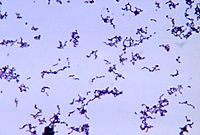
Photo from wikipedia
Ulva fenestrata is an economically and ecologically important green algal species with a large potential in seaweed aquaculture due to its high productivity, wide environmental tolerance, as well as interesting… Click to show full abstract
Ulva fenestrata is an economically and ecologically important green algal species with a large potential in seaweed aquaculture due to its high productivity, wide environmental tolerance, as well as interesting functional and nutritional properties. Here, we performed a series of manipulative cultivation experiments in order to investigate the effects of irradiance (50, 100, and 160 μmol photons m−2 s−1), temperature (13 and 18 °C), nitrate (< 5, 150, and 500 μM), phosphate (< 1 and 50 μM), and pCO2 (200, 400, and 2500 ppm) on the relative growth rate and biochemical composition (fatty acid, protein, phenolic, ash, and biochar content) in indoor tank cultivation of Swedish U. fenestrata. High irradiance and low temperature were optimal for the growth of this northern hemisphere U. fenestrata strain, but addition of nutrients or changes in pCO2 levels were not necessary to increase growth. Low irradiance resulted in the highest fatty acid, protein, and phenolic content, while low temperature had a negative effect on the fatty acid content but a positive effect on the protein content. Addition of nutrients (especially nitrate) increased the fatty acid, protein, and phenolic content. High nitrate levels decreased the total ash content of the seaweeds. The char content of the seaweeds did not change in response to any of the manipulated factors, and the only significant effect of changes in pCO2 was a negative relationship with phenolic content. We conclude that the optimal cultivation conditions for Swedish U. fenestrata are dependent on the desired biomass traits (biomass yield or biochemical composition).
Journal Title: Journal of Applied Phycology
Year Published: 2020
Link to full text (if available)
Share on Social Media: Sign Up to like & get
recommendations!